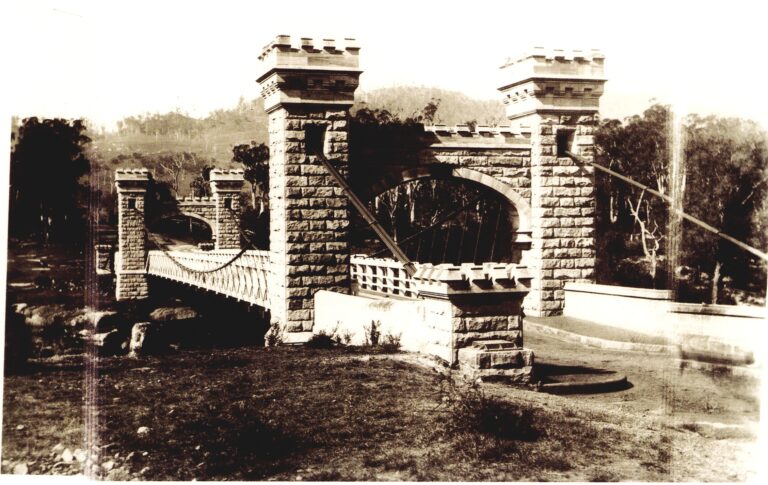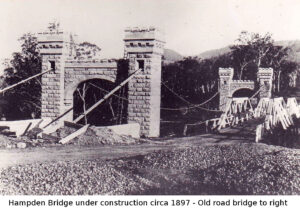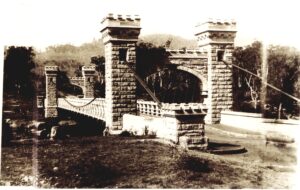
Hampden Bridge is Australia’s last surviving wooden suspension bridge and the only surviving suspension bridge from the colonial period in NSW. The bridge was named after Lord Hampden, Governor of New South Wales from 1898 to 1899. It was opened to traffic on 2 February 1898, 124 years ago. The official opening took place on 19 May 1898. The Bridge was added to the New South Wales Heritage Register on 2 August, 2019.
The headline in the Shoalhaven Telegraph on 4 April 1896, on behalf of the Kangaroo Valley Times, was “A Magnificent Bridge” which was reported to be erected over the Kangaroo River. The new bridge was to be situated close to the then wooden bridge, on the up-stream side of that current bridge. To carry the cables there would be erected on each side of the river a pair of 42 ft high and 8 ft square towers of sandstone masonry, procured from the immediate vicinity of the bridge. The deck of the bridge is about 60 ft above water in the river. The total length of the bridge and approaches was to be 928 ft. The contractors were Messrs Loveridge and Hudson and the architect was Ernest de Burgh, the colony’s Assistant Engineer for Bridges.
A start on the bridge was recorded in the Goulburn Herald on 14 July 1897. After delays wire-rope cables were being run across the river, the first of the 28 being drawn across. The ropes arrived on wooden reels which had been placed in a frame to facilitate unrolling.
Each of the ropes weighed about 18 cwt (2,822 kg),. being 1½ inches in circumference and 180 ft in length. The strands were made up of 49 wires of plough steel. These had been tested in England to carry between 80 and 90 tons without failure or fracture of the strands.
The reels were placed on the Moss Vale side of the river; the wire cables were then drawn by a manilla rope and passed across the river to a winch on the Nowra side. They were then passed down the vertical anchor chamber shafts to the links and bolts which secured them to the anchorage girders dovetailed into the recess at the bottom of the shaft. The ropes were then adjusted to the correct dip which is between 19 ft and 20 ft when the bridge was complete. Thermometric readings had to be taken into account when setting the rope. The Moss Vale end of the cables were then passed down to that anchor chamber, measured out to proper length and also fixed to the anchorage bolts. The 28 cables were distributed in four nests of seven in each, two nests on each side of the bridge; each nest is arranged in the shape of a hexagon with a cable in centre forming a core. Each pair of nests were securely fixed permanently in position by clips, to which were attached the suspension bolts which virtually carry the structure of the bridge.
Most of the timber-decking and the ironwork for the structure was carted over from Nowra by Mr Cason. The majority of the ironbark scantlings was cut down at Jack’s Corner.
Kangaroo Valley Times – After rain gathered intensity on 13 February 1898 it continued to alarming levels which found flood waters moving into local homes in the township. The astounding height of the flood had been compared to the 1870 severe floods with “green pastures transformed into a seething, boiling, headlong flowing lake, carrying in its resistless course dead and dying horses, cattle, pigs, ducks, fowls, monster trees, fences, etc.” The flood was a full height when “it gave an example of its wonderful strength by carrying away bodily the old Kangaroo Valley bridge. The structure was of course being taken to pieces, but as only some of the top timber had been removed, it had not been weakened at all.“ The flood peak reached 55 ft. The new bridge was 6 ft 7 inches higher than the previous bridge.
Christine Murphy


